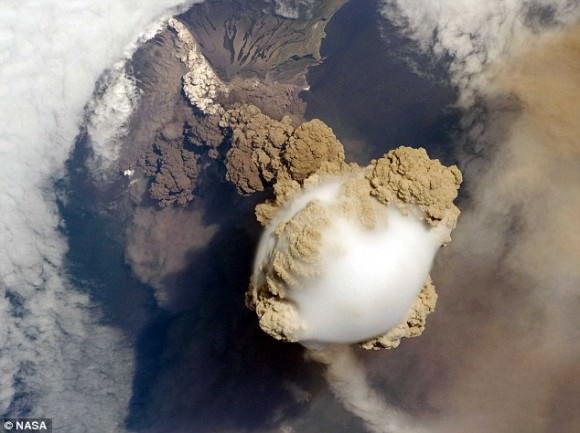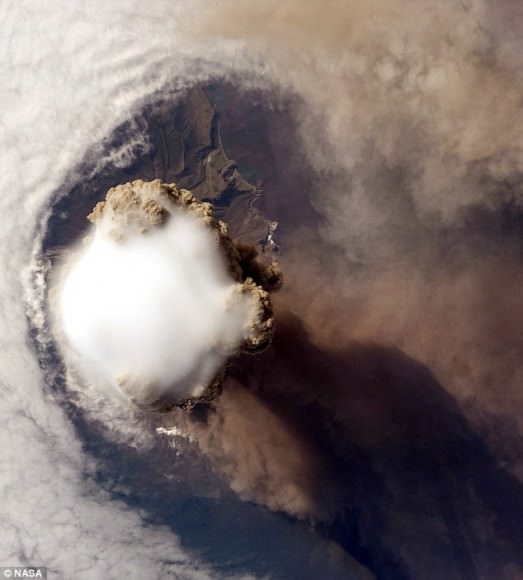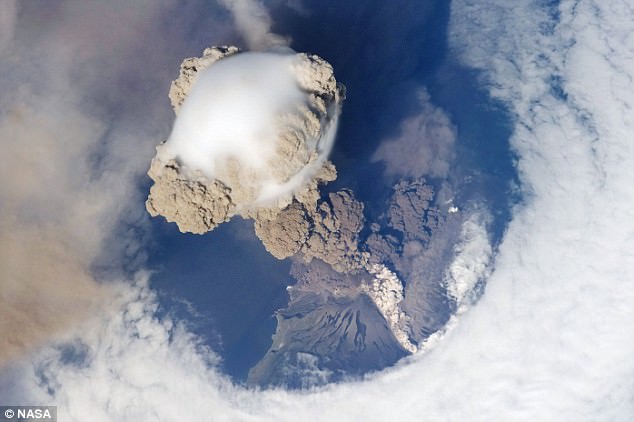[/caption]
These images of Sarychev Volcano were popping up everywhere in the internet yesterday, but unfortunately I was out of intertube contact most of the day. But these images are too awesome not to share! Astronauts on board the International Space Station took these striking views of Sarychev Volcano (Kuril Islands, northeast of Japan) on June 12, 2009. Notice the shock wave around the edge of the volcano’s plume and the “hole” the clouds that the eruption caused. Sarychev Peak is one of the most active volcanoes in the Kuril Island chain, and it is located on the northwestern end of Matua Island. Here are few more images taken in sequence as the ISS flew 354 km (220 miles) overhead:

Volcanologists say these images are exciting because they capture several phenomena that occur during the earliest stages of an explosive volcanic eruption. The main column is one of a series of plumes that rose above Matua Island on June 12. The plume appears to be a combination of brown ash and white steam. The vigorously rising plume gives the steam a bubble-like appearance. The eruption cleared a circle in the cloud deck. The clearing may result from the shockwave from the eruption or from sinking air around the eruption plume: as the plume rises, air flows down around the sides like water flowing off the back of a surfacing dolphin. As air sinks, it tends to warm and expand; clouds in the air evaporate.
Also visible is material from the eruption falling down the slopes of the volcano.

These images were taken by the Expedition 20 crew on the ISS, using a Nikon D2XS digital camera fitted with a 400 mm lens, and is provided by the ISS Crew Earth Observations experiment and Image Science & Analysis Laboratory, Johnson Space Center.
Source: NASA Earth Observatory


Wow! Impressive.
This article is copy/pasted from Nasa’s Earth Observatory website.
Down to the silly ‘shockwave’ bit. 🙁
At least in the original they only mention it to explain the ‘hole in the clouds’ (which I doubt), not the pileus cloud ‘around the edge of the volcano’s plume’.
Shockwaves happen when something moves at supersonic speeds: I doubt this is the case here.
Pileus clouds commonly happen above large masses of warm air moving upward, such as storm clouds.
Great image though.
If you throw a stone on a pond, it will create shockwaves, so there’s no need to go supersonic at all.
And, do you think a volcanic blast doesn’t go supersonic? I don’t know, but for sure I think it may be very possible!
Well, to be specific, a shockwave happens when something moves faster than a ‘normal’ wave in a given medium.
It can be sound, light (Cerenkov effect) or, under certain conditions, surface waves on water (as in a tidal bore).
The confusion here, is that the pileus cloud ‘looks like’ the shockwaves we’ve seen materializing as clouds around aircraft or nuclear bombs.
But even if there was one (OK, maybe the initial stage of the explosion might be supersonic) it would have expanded and dissipated very, very fast, much before the plume could rise so high.
And I still doubt (but this is just a guess) that even if there was one, it could have expanded to the size of the ‘hole’.
It seems much more realistic (still guessing) that the rising plume induces downward air movement further out.
Shockwave or not, I think we can all agree this image is at *least* 6 kinds of Awesome!
I think, next to astronomical images, volcanoes provide the most interesting and beautiful subjects of imagery in nature. Thanks for posting these truly unique and beautiful examples.
Shock waves are indeed waves travelling faster than sound in that medium. In the case of light that is how Cherenkov radiation is produced, and for a chemical reaction propagating through a highly reactive media it is an explosion. For a volcano the shock wave is probably a brief affair that is long disappated by the time a plume reaches the upper troposphere.
3-D version
http://antwrp.gsfc.nasa.gov/apod/image/0906/ISS020-E-9050_52ana_public.jpg
There has been a 3D version of this photo circulating that unfortunately requires those pesky red/blue 3D glasses. You think maybe someone could come up with a “Parallel Vision” version, like the one you recently ran of NGC 7635?
http://www.universetoday.com/wp-content/uploads/2009/06/bub_cross.jpg
Is the cloud layer surrounding the island burned off from the rising heat of the volcano, rather than blown away by the wind created by the explosion? Such as a fog being burned off by the sun, the clouds were burned off from underneath.
DEAR ROSS:
THANK YOU SO MUCH for passing that link along!
CHUCK ANZIULEWICZ
SpaceWeather.com has the “no glasses required” 3D version. You can see it at:
http://spaceweather.com/swpod2009/24jun09/vantuyne2.jpg